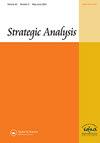Eastwards Ho? India’s Relations with the Indo-Pacific
IF 0.5
Q3 INTERNATIONAL RELATIONS
引用次数: 0
Abstract
E astwards Ho? India’s Relations with the Indo-Pacific edited by E. Sridharan comprising 15 essays by renowned experts on Asian geopolitics, seeks to place India on the strategic map of the evolving Indo-Pacific region as an economic and geopolitical power. At the outset, the editor provides a succinct overview of economic integration in Asia, particularly of China with its neighbours reflected in a massive increase in bilateral and multilateral free trade agreements (FTAs). He points out that despite the absence of a North Atlantic Treaty Organization (NATO)like security umbrella, East Asian countries have managed to strengthen intraregional economic integration (p. 6). China’s actions have been belligerent but Asian countries do not stand decoupled from China in terms of their economy. In fact, one may argue that NATO-like military alliances do more harm than good. Especially as Russia’s primary contention has apparently been over NATO’s expansion in Europe, leading to the Ukraine crisis. In relation to India’s diplomacy in the Indo-Pacific, Sridharan suggests enlargement of the Indian Foreign Service, strengthening ties between government, academia and think tanks, boosting Diaspora linkages, and increasing institutionalized involvement of India’s states in foreign policy (p. 15). The book explores the Asian security architecture and India’s endeavour to play a larger role in it, given the ongoing fundamental shifts in global and regional balance of power. The Indo-Pacific is replete with multilateral fora, mainly ASEAN-led institutions like the East Asia Summit, which have adequate representation, including China. This has led to a web of overlapping multilateral organizations allowing participation of multiple stakeholders. India’s role, hence, will increasingly become more important based on the multilateral or ‘minilateral’ institutions it helps forge, and how it participates and shapes their agenda in pursuance of its national interest. Srikanth Kondapalli argues that economic interdependencies are not enough to influence India’s and China’s security policies. China’s increasing economic and diplomatic outreach in South Asia will compel New Delhi to invest resources for maintaining its predominant position in the Indian Ocean Region (IOR) and transform its diplomatic approach towards South Asian neighbours. India may approach development of borderlands with renewed focus, and efforts to radically increase economic and people-to-people exchanges with the neighbouring countries. Strategic Analysis, 2022 Vol. 46, No. 5, 545–547, https://doi.org/10.1080/09700161.2022.2115233向东何?印度与印太关系
何?E.Sridharan编辑的《印度与印太关系》由著名亚洲地缘政治专家撰写的15篇文章组成,旨在将印度作为一个经济和地缘政治大国置于不断发展的印太地区的战略地图上。首先,编者简要介绍了亚洲经济一体化,特别是中国与邻国的经济一体化,这反映在双边和多边自由贸易协定的大幅增加中。他指出,尽管没有北大西洋公约组织那样的安全保护伞,东亚国家还是设法加强了区域内的经济一体化(第6页)。中国的行动是好战的,但亚洲国家在经济方面并没有与中国脱钩。事实上,有人可能会说,类似北约的军事联盟弊大于利。尤其是俄罗斯的主要争论显然是北约在欧洲的扩张,导致了乌克兰危机。关于印度在印太地区的外交,斯里达兰建议扩大印度外交部,加强政府、学术界和智库之间的联系,加强海外联系,并增加印度国家在外交政策中的制度化参与(第15页)。鉴于全球和地区力量平衡正在发生根本性变化,这本书探讨了亚洲安全架构以及印度在其中发挥更大作用的努力。印太地区充满了多边论坛,主要是东盟领导的机构,如东亚峰会,这些机构有足够的代表性,包括中国。这导致了一个由重叠的多边组织组成的网络,允许多个利益攸关方参与。因此,印度的作用将变得越来越重要,这取决于它帮助建立的多边或“小型”机构,以及它如何根据国家利益参与和制定其议程。Srikanth Kondapalli认为,经济相互依存不足以影响印度和中国的安全政策。中国在南亚日益扩大的经济和外交联系将迫使新德里投入资源,以保持其在印度洋地区的主导地位,并改变其对南亚邻国的外交方式。印度可能会重新关注边境地区的发展,并努力从根本上增加与邻国的经济和人文交流。战略分析,2022年第46卷,第5期,545–547,https://doi.org/10.1080/09700161.2022.2115233
本文章由计算机程序翻译,如有差异,请以英文原文为准。
求助全文
约1分钟内获得全文
求助全文

 求助内容:
求助内容: 应助结果提醒方式:
应助结果提醒方式:


